
Embedded leases under ASC 842
When it comes to ASC 842 compliance, organizations may find themselves stepping into detective mode. Identifying contracts that contain embedded leases often requires a detailed and thoughtful examination. While the requirement to search for embedded lease isn’t new, the updated standard under ASC 842 has brought this issue into sharper focus. Failing to identify Embedded lease accurately can significantly impact financial statement reporting.
In this blog, we will explore the intricacies of embedded lease identification, discuss common areas where these leases may hide, and outline best practices to ensure compliance with ASC 842.
Understanding the Shift: ASC 840 vs. ASC 842
The definition of a lease under ASC 842 is similar to its predecessor, ASC 840. However, the major shift lies in the financial reporting requirements. Under ASC 840, operating leases and service contracts were often expensed similarly, which meant companies were not always rigorous about identifying embedded leases.
ASC 842 changes the game by requiring most leases to be recorded on the balance sheet. This has far-reaching implications across industries, including manufacturing, telecommunications, financial services, and pharmaceuticals. The new rules apply to public business entities starting from fiscal years beginning after December 15, 2018, and for all other entities from fiscal years beginning after December 15, 2021.
What Is an Embedded Lease?
An embedded lease is a lease contained within a broader contractual agreement. While the word “lease” might not explicitly appear in the contract, if the agreement conveys the right to control the use of a specified asset for a period in exchange for consideration, it qualifies as a lease under ASC 842.
Examples of Embedded Leases
- Advertising Contracts: Renting billboards may qualify as a lease if the advertiser controls the billboard’s use during the contract period.
- IT Hosting Agreements: Hosting data on a dedicated server might meet the lease criteria if the company has control over the server.
- Contract Manufacturing: Agreements requiring exclusive use of specific facilities or equipment for manufacturing products can contain embedded lease.
- Transportation Services: Using specified railcars or delivery trucks for transporting goods may involve an embedded lease.
Common Areas Where Embedded Leases May Be Hiding
Identifying the leases requires examining various contracts that may inadvertently meet the definition of a lease. Here are some common areas to investigate:
- Information Technology Contracts: Hosting data on dedicated servers.
- Cable and Satellite Services: Use of set-top boxes.
- Transportation and Delivery Services: Leasing railcars or vehicles for exclusive use.
- Advertising Agreements: Rights to specific billboards or signage.
- Contract Manufacturing: Dedicated tooling or facilities.
- Power Purchase Agreements: Use of specific power plants.
- Complex Service Contracts: Equipment or property involved in service delivery.
- Joint-Operating Agreements: Usage of drilling rigs or other specified assets.
Best Practices for Identifying Embedded Leases
To ensure compliance with ASC 842, companies should adopt a systematic approach to identify and account for the leases:
1. Scrutinize All Contracts
Evaluate every contract within the organization to determine if it involves the use of a specified asset. Collaborate with legal, procurement, and operations teams to ensure a thorough review.
2. Translate Technical Concepts
Explain ASC 842’s lease definition in simple terms for non-accountants. For instance, instead of asking if a contract contains a lease, ask whether it involves exclusive use of an asset for delivering the service.
3. Perform Risk Assessments
Identify areas with higher likelihood of the leases. For example, industries with stringent regulatory requirements may necessitate dedicated equipment, which could qualify as a lease.
4. Review General Ledger Activity
Analyze recurring expense entries to identify payments for potential lease-related assets. Regular payments, such as monthly IT service fees, may signal a need for further investigation.
5. Conduct Physical Inspections
Visit offices or manufacturing sites to identify assets that might not be listed in the asset registry but could qualify as leased items under ASC 842.
6. Engage Accounting Advisors
Given the complexity and judgment involved, consulting with accounting experts can ensure proper identification and documentation of the leases.
Real-World Examples of Embedded Leases
Understanding practical examples can make the concept of the leases more relatable:
- Railcars: A transportation contract granting exclusive use of railcars during the agreement term contains an embedded lease.
- Contract Manufacturing: A shoe retailer’s agreement with a manufacturer requiring exclusive use of a facility and equipment for production includes embedded leases.
- IT Services: A hospital’s IT service agreement requiring a dedicated server for HIPAA compliance involves an embedded lease for the server.
Ongoing Accounting Considerations
Complying with ASC 842 doesn’t stop at implementation. Companies must establish robust processes and internal controls to:
- Identify new contracts that may contain the leases.
- Monitor changes to existing contracts that could trigger reassessment or modification.
- Ensure accurate and consistent reporting of lease-related expenses.
For more information you can refer:
- How to Adopt the New Lease Standard for Private Companies (EISNE Ramper)
- 5 FAQs About Embedded Leases (LeaseCrunch)
- How to Identify Embedded Leases Within Contracts (Nakisa)
- Hidden in Plain Sight: Accounting for Embedded Leases (Journal of Accountancy)
- Understanding ASC 842 Compliance: 4 Key Internal Controls for Sustainable Lease Accounting (Dolfinn)
Conclusion
The transition to ASC 842 represents a significant shift in lease accounting. Identifying and accounting for embedded lease is a critical part of compliance, requiring organizations to thoroughly examine contracts, implement diligent processes, and engage cross-functional teams. By adopting best practices and leveraging expert guidance, companies can navigate the complexities of embedded lease identification and ensure accurate financial reporting under ASC 842.
FAQs
1. What is an embedded lease under ASC 842?
An embedded lease is a lease contained within a broader agreement, where the contract grants control over a specified asset for a period in exchange for consideration.
2. Why is identifying embedded lease is important?
Failing to identify embedded lease can lead to misstatements in financial reporting and non-compliance with ASC 842, potentially resulting in penalties and reputational risks.
3. What industries are most impacted by ASC 842?
Industries such as manufacturing, IT services, telecommunications, financial services, and healthcare are heavily impacted due to their frequent use of complex service agreements.
4. What are some tools for identifying embedded lease?
Surveys, contract reviews, risk assessments, and physical inspections are effective tools. Collaborating with legal and accounting experts also ensures thorough identification.
5. What changes are required for ongoing compliance?
Organizations must update processes, train teams, and implement controls to identify new contracts, monitor changes to existing agreements, and reassess lease-related accounting regularly.
Summary
Discover how identifying embedded leases under ASC 842 impacts balance sheet reporting. Learn actionable steps to ensure compliance and improve financial accuracy.
Latest Posts
- Top Cash Flow Forecasting Tools You Can’t Ignore for Global Businesses

- Mastering Profit vs. Cash Flow: 5 Key Strategies for Financial Success

- 5 Key Advantages and Disadvantages of Outsourced Accounting: Is Outsourced Accounting Worth the Risk?

- Mastering Cash Flow Management in 2025: 7 Proven Strategies for Financial Success

- Mastering International Tax Compliance: 7 Crucial Strategies for Multinational Success

- 5 Common Bookkeeping Mistakes Small Businesses Make and How to Avoid Them

